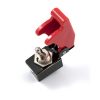Maybe years ago when Flintstone was a hell-raiser in high school and they were out at midnight hitting mailboxes with a baseball bat and he thought his buddy's suggestion to "...put pee in a can up high" was "...put in a pecan pie".
Hey, it happened to me like that once....or something similar. I was pretty wasted.
What about designing a “noise-free” fecal crossbow arrow? Use an auto-tracking PTZ cam, mounting the ballista at bottom. The car horn will activate a shoot round of fecal balls. Loading the balls are the most difficult part. The video will gain popularity in YT (you may even monetize)



